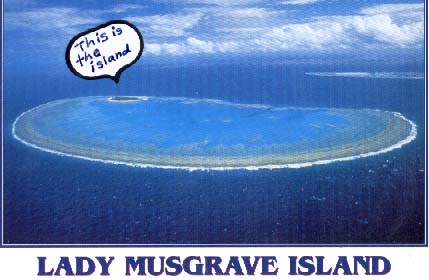 Lady Musgrave Island is a true coral cay situated off the
east coast of Australia 37 miles east of the Town of 1770 and
62 miles northeast of the city of Bundaberg. This 35 acre island
is surrounded on all sides by a breathtakingly beautiful 3,000 acre
coral lagoon which is unique to the entire Great Barrier Reef region.
Lady Musgrave Island is a true coral cay situated off the
east coast of Australia 37 miles east of the Town of 1770 and
62 miles northeast of the city of Bundaberg. This 35 acre island
is surrounded on all sides by a breathtakingly beautiful 3,000 acre
coral lagoon which is unique to the entire Great Barrier Reef region.
A National and Marine Park, Lady Musgrave Island and her surrounding waters
are filled with over 1,200 varieties of brilliantly colored marine fish
and over 200 species of both soft and hard coral. The tree lined canopy
of the island is home to thousands of migratory sea birds with the coral
sand beaches creating a major offshore nesting area for green loggerhead
sea turtles. There is a national park camping ground on the western side
of the island, but there is no water, electricity, or other facilities
except for a bush toilet.
Enticed by the brochures, we learn that there are two companies that
run day cruises to Lady Musgrave Island. The 51 foot "M.V. Spirit of 1770"
departs from the Town of 1770 and takes 1.5 hours each way, and the 79 foot
"M.V. Lady Musgrave" departs from Bundaberg and takes 2.7 hours each way.
They will drop off and pickup campers but charge each person two
round trip cruise fares. Having a yearning for adventure,
we plan a four night camping trip.
The M.V. Spirit of 1770 is planning a cruise the next day so
we book with them. They charge our Visa credit card the $284 for four
round trip tickets and tell us that they will provide our drinking water.
We purchase a national park camping permit for $4.50 per day
and drive to a motel in Agnes Waters near the Town of 1770.
While at the motel we condense our camping gear so that we have only one
large duffel bag and an ice chest, both items fitting nicely on our large
luggage cart.
Day 1.
On February 5, 1999, we drive to the boat dock at 7:30 AM
and park our rental car leaving our unneeded gear in the trunk.
The boat people had forgotten our water, but they found a jug which
will hold a two day supply, and they say that they will bring us another
two day supply on their next cruise in two days. We say "okay" and
request that they also bring us a block of ice for our cooler chest.
The ocean has two meter swells, and the boat trip was very rough.
But once we enter the Lady Musgrave Lagoon, the water is calm
and beautiful with varying colors due to the coral below.
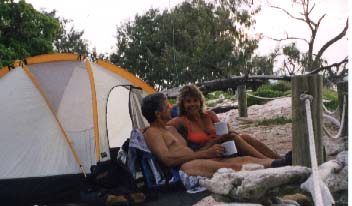 The boat is anchored to a buoy on the east side of the island.
We reject the free lunch on board the boat, because we are eager to set
up our campsite and explore the island. They ferry us and our gear
to the island in a glass bottom boat. There is a trail through
the trees to the campground, which took us fifteen minutes to walk.
We are the only campers on the island, and we choose the best campsite under
a tree and overlooking the lagoon. There are
some large logs and pieces of coral in front of the campsite, which we
learn later are to keep the large turtles from coming into our tent.
The boat is anchored to a buoy on the east side of the island.
We reject the free lunch on board the boat, because we are eager to set
up our campsite and explore the island. They ferry us and our gear
to the island in a glass bottom boat. There is a trail through
the trees to the campground, which took us fifteen minutes to walk.
We are the only campers on the island, and we choose the best campsite under
a tree and overlooking the lagoon. There are
some large logs and pieces of coral in front of the campsite, which we
learn later are to keep the large turtles from coming into our tent.
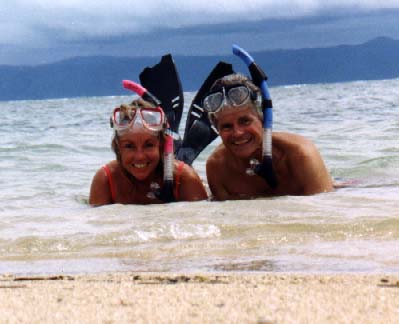 It is a beautiful day, and we are hot from setting up camp. We
cool off by snorkeling in the lagoon. We see for the first time the beauty
of the colorful underwater fish and coral. We then take a walk around the
beach of the entire island. It is about a 30 minute walk, but we
take much longer because we stop many times to enjoy the spectacular
scenery. On the south side of the island there is a metal tower with
a solar powered lighthouse on top. The only building on the entire
island is the "bush toilet" on the south side. But it is the most
impressive outhouse that we have ever seen because it is a solar powered
composting toilet. There is no smell, and we marvel at how it works.
A sign says that the compost is used as fine top soil.
It is a beautiful day, and we are hot from setting up camp. We
cool off by snorkeling in the lagoon. We see for the first time the beauty
of the colorful underwater fish and coral. We then take a walk around the
beach of the entire island. It is about a 30 minute walk, but we
take much longer because we stop many times to enjoy the spectacular
scenery. On the south side of the island there is a metal tower with
a solar powered lighthouse on top. The only building on the entire
island is the "bush toilet" on the south side. But it is the most
impressive outhouse that we have ever seen because it is a solar powered
composting toilet. There is no smell, and we marvel at how it works.
A sign says that the compost is used as fine top soil.
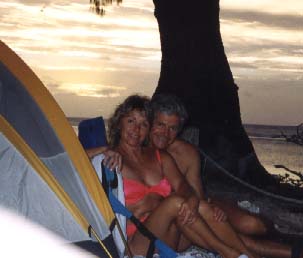 At 3:45 PM the M.V. Spirit of 1770 departs, leaving us in peace with nature
as the only people on the island.
Returning to our campsite, a beautiful sunset is starting
to form as we both take refreshing solar showers. While watching the
sunset we cook and eat a nice dinner of steak with mushrooms and wine.
A candle-like atmosphere is provided by our Ultra Light Lantern. The
evening is completed with a toast of Grand Marnier, our favorite camping
nightcap.
At 3:45 PM the M.V. Spirit of 1770 departs, leaving us in peace with nature
as the only people on the island.
Returning to our campsite, a beautiful sunset is starting
to form as we both take refreshing solar showers. While watching the
sunset we cook and eat a nice dinner of steak with mushrooms and wine.
A candle-like atmosphere is provided by our Ultra Light Lantern. The
evening is completed with a toast of Grand Marnier, our favorite camping
nightcap.
Day 2.
We awake to sounds of ocean waves and chirping birds.
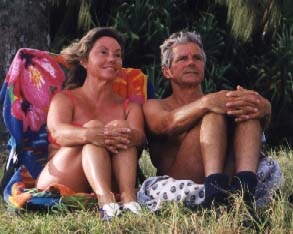 Looking in the
sand, we see the three foot wide tracks of two turtles which had nested near
our tent during the night, but we are disappointed that we did not see them.
It is another glorious day. After breakfast it is getting hot on our
leeward side of the island, so we pack up our Therma Lounger chairs,
towels, and snorkel equipment, and we go to the south side of the island
where there is a cool southeasterly breeze. Here we have a memorable day
sunbathing, snorkeling, watching birds, and looking at the beautiful
turquoise water. Hours are spent sitting on the grass in the shade
looking at the splendid sights with a refreshing 15 knot wind blowing
in our faces.
Looking in the
sand, we see the three foot wide tracks of two turtles which had nested near
our tent during the night, but we are disappointed that we did not see them.
It is another glorious day. After breakfast it is getting hot on our
leeward side of the island, so we pack up our Therma Lounger chairs,
towels, and snorkel equipment, and we go to the south side of the island
where there is a cool southeasterly breeze. Here we have a memorable day
sunbathing, snorkeling, watching birds, and looking at the beautiful
turquoise water. Hours are spent sitting on the grass in the shade
looking at the splendid sights with a refreshing 15 knot wind blowing
in our faces.
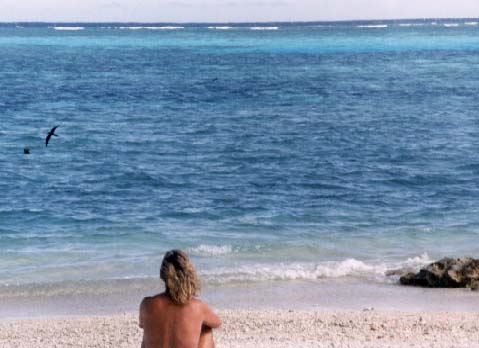 With the binoculars we brought, we become fascinated by the water in
the lagoon. The color patterns change as the tide and sun change.
It appears to be a painting in motion. In the distance we see
the white caps of waves breaking on the outer reef. In the lagoon
we see several large fish and turtles and a few manta rays. Overhead
the majestic birds are flying while some are landing on the beach and in
the trees. This must be paradise!
With the binoculars we brought, we become fascinated by the water in
the lagoon. The color patterns change as the tide and sun change.
It appears to be a painting in motion. In the distance we see
the white caps of waves breaking on the outer reef. In the lagoon
we see several large fish and turtles and a few manta rays. Overhead
the majestic birds are flying while some are landing on the beach and in
the trees. This must be paradise!
The M.V. Lady Musgrave boat from Bundaberg comes to the island today,
but we see only four people who happen to walk around to the south side
of the island. Most people stay on or near the boat out in the lagoon.
When we return to our campsite, we find a couple, Leslie and Tony, who
had come out on the M.V. Lady Musgrave boat, and they are setting up camp
around the corner and out of sight of our tent. They are from Brisbane,
having immigrated to Australia from southern England.
In the evening we shower and prepare another candlelight dinner of chicken
stew, bread, butter, and wine. The sky is cloudless, so we leave the rain
fly off of our Walrus Tri-Star tent and stare at the beautiful stars
through the mesh top as we enjoy some Grand Marnier.
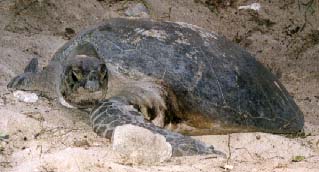 Day 3.
In the early morning we hear a turtle moving about six feet away from our
tent, so we get up to take pictures. She digs a big hole and spends
about one and one half hours laying her eggs. She covers her eggs by
sweeping sand into the hole with her flippers and then goes slowly back
out to sea. She must have weighed 150-200 pounds.
Later that day, we see some three inch turtle hatchlings coming up out
of holes in the ground. They are from eggs that had been laid about ten
weeks earlier. The sea gulls are swooping down and picking up the baby
turtles. We try to chase the sea gulls away,
and Lou helps one trapped baby turtle by picking it up and taking it to
the lagoon so it can swim to safety.
Day 3.
In the early morning we hear a turtle moving about six feet away from our
tent, so we get up to take pictures. She digs a big hole and spends
about one and one half hours laying her eggs. She covers her eggs by
sweeping sand into the hole with her flippers and then goes slowly back
out to sea. She must have weighed 150-200 pounds.
Later that day, we see some three inch turtle hatchlings coming up out
of holes in the ground. They are from eggs that had been laid about ten
weeks earlier. The sea gulls are swooping down and picking up the baby
turtles. We try to chase the sea gulls away,
and Lou helps one trapped baby turtle by picking it up and taking it to
the lagoon so it can swim to safety.
Later we walk to the east side of the island and meet the captain of the
M.V Spirit of 1770 boat which had come in today. He brings our
second two day supply of water, but he forgot the block of ice.
We talk him into going back to the docked boat and getting us two ice
cube trays of ice and four cold beers, which we take back to our
campsite and have lunch.
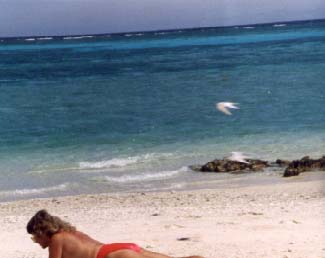 In the afternoon we go back to "our spot" on the south side of the island
where the sun is bright and Lou sunbathes. We also read books, enjoy a
cold beer, and relax to the sights and sounds of the island.
It eventually starts to rain so we
put up our Shelt-a-Hut, a portable rain and sun shelter, but the rain does
not let up, and we head back to our tent while getting drenched by the
rain. We dry off and have dinner, wine, and Grand Marnier in our tent.
In the afternoon we go back to "our spot" on the south side of the island
where the sun is bright and Lou sunbathes. We also read books, enjoy a
cold beer, and relax to the sights and sounds of the island.
It eventually starts to rain so we
put up our Shelt-a-Hut, a portable rain and sun shelter, but the rain does
not let up, and we head back to our tent while getting drenched by the
rain. We dry off and have dinner, wine, and Grand Marnier in our tent.
Day 4.
We are awakened at 4 AM by smashing and ripping noises. A giant turtle
is tearing its way into the back of our tent! Archie turns on a flashlight
and makes noises which frighten the turtle into turning away. She had laid
her eggs in a hole behind our tent and was going back to the water by
the shortest route. The rain fly of our tent was ripped in three places
by the powerful flippers of the turtle. After the sun comes up and we
have had breakfast, we attempt to fortify all sides of our tent by making
a twelve inch wall out of logs and pieces of dead coral. It is interesting
to note that we were never able to find any rocks on the island, only
coral, but we guessed that that is normal on a coral cay.
The weather is warm and sunny all day. We truly enjoy our "last" full day
on the island. We have tuna fish sandwiches and our last two warm beers
for lunch. For dinner we eat a stockpot soup with bread and finish
off the last of our wine. We also drink the last of our Grand Marnier.
Day 5.
We are up early to pack all of our equipment and break camp. We load
everything onto our luggage cart and hike across the island to the east side
where the boat will pick us up.
The boat does not come! Archie reassures Lou, "no worries, Mate, this just
means that we get to spend one more day in paradise"!
We haul our equipment back to the campground on the west side of the
island and put our tent back up in the same spot. Our neighbors Leslie
and Tony have a radio, and they tell us that the mainland near Bundaberg
is having high seas and winds and that a cyclone named Rona is forming
several miles north of us off the coast of Cairns. The word "cyclone"
is what the Australians use for what we call a "hurricane." The
difference is that tropical cyclones in the southern hemisphere rotate
clockwise instead of counterclockwise.
We realize now that we may be in considerable trouble. We do not take
solar showers, and we try to conserve water because our supply is low.
We talk to Leslie and
Tony again and learn that gale force winds of 50 knots are expected
in our general area overnight, so we anchor the stakes of our tent as best
we can. We have an early dinner of canned soup, bread, and water.
We miss not having any more wine or Grand Marnier!
Day 6.
The winds are strong and whistling during the night, and it rains heavily
off and on. We cannot sleep, and we discuss what we will do if the winds
blow our tent away. We decide that we would run for the toilet, which is well
constructed, and get in it, behind it, or under it. And if the toilet blows
away, we would get into one of the turtle holes and put a tarp over
ourselves.
It is sunny in the morning, but still breezy. We look for boats, but
none come today!
Tony tells us that
the radio says the town of Gympie is flooded, and there are flood
warnings for all of the mainland area north and west of us. The mainland
coast is being battered by rain and 5 meter waves. We realize that we are
fortunate to have sunshine and to be protected by the outer reef, which is
breaking the large waves and creating the calm water which we see around
Lady Musgrave Island.
For breakfast we have one piece of bread and the last of our cheese and
coffee. We are trying to conserve food, so we do not eat any lunch.
Then we take a walk to "our spot" and read books until it starts to rain.
We walk inland through the trees to the east side of the island where there
is an information board describing the different types of birds and plants
on the island. We write down the information, and the rain stops. As we
continue walking back to our campsite we try to identify the birds and
plants that we pass. For dinner we eat our last can of food and our last
two pieces of bread. We have left only two apples and two candy bars.
Our remaining water is getting very stale tasting and Leslie gives us a
little orange concentrate to put in it. We go to bed early and sip a
little of this water and pretend that it is Grand Marnier.
Day 7.
The winds are again howling during the night with intermittent rain.
We meet with Tony and Leslie early in the morning.
The radio report says that Cyclone Rona
is moving slowly to the south and west near Cairns with winds up to
180 kph (112 mph). If it goes west, we should be okay,
but if it comes south, we could be in danger. Tony says it is
possible that we could be stuck on this island for another week and,
therefore, we should start preparing for that possibility.
Consequently, Tony and Archie rig up a large plastic tarp to form a funnel
for catching rain water. Archie had brought a fishing line on a spool
and some hooks which he had not used. We unroll the line and
divided it into two pieces so both Archie and Tony can fish. We
split up. Tony and Leslie, who are strong swimmers, swim out to a pontoon
on the east side of the lagoon where the tour boats tie up, and they fish
from there. We go to the south side to fish from the bank.
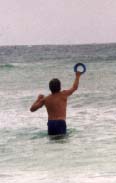 Archie fishes for most of an hour with no luck. The wind is blowing
so hard that he cannot get his line out nor control it. It is raining
again, and he is getting drenched. We sit for awhile in
a sheltered area under a tree, but we are getting weak from not
eating all day, so we eat our last two apples core and all.
We decide to save the two candy bars for the very last.
Archie fishes for most of an hour with no luck. The wind is blowing
so hard that he cannot get his line out nor control it. It is raining
again, and he is getting drenched. We sit for awhile in
a sheltered area under a tree, but we are getting weak from not
eating all day, so we eat our last two apples core and all.
We decide to save the two candy bars for the very last.
As we walk through the trees back towards our tent, we look at the
many birds, and we decide that they could provide a source of food.
The largest birds on the island are the silver sea gulls,
and Archie sets out to catch one. He gets a large garbage bag provided
in a container next to the toilet and puts a heavy piece of coral in
it. He spends about half an hour trying to sneak up on one and club it,
but the gulls are very alert, and it is getting discouraging. Finally,
he gets lucky and hits one and grabs it before it gets away, and he puts
it in the sack.
We go back to the campground and Archie strains the rain water that
had collected into a water jug. There was only about one half a liter.
A little later Tony and Leslie return to the campground. Tony
had caught three small fish from the pontoon, and he shared some with us.
We offer them some of our prized sea gull, but they do not take any.
We are relieved that we have some food for dinner. Lou cooks the fish
and gull with some of her French herbs in olive oil. The sea gull was
smaller and tougher than a cornish game hen, but we were very hungry, and
it tasted like a gourmet meal. It would have been better with wine and
Grand Marnier!
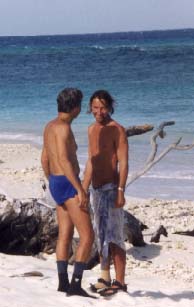 Day 8.
The winds did not blow as hard during the night, and it did not rain.
Hopefully, this means that Cyclone Rona is not coming south. In the morning
Archie checks his fishing line which he had left tied to a tree
branch, but no luck.
Day 8.
The winds did not blow as hard during the night, and it did not rain.
Hopefully, this means that Cyclone Rona is not coming south. In the morning
Archie checks his fishing line which he had left tied to a tree
branch, but no luck.
Later, Tony and Archie learn an easier way to catch sea gulls. Tony
holds up his hammock and puts some bait under it. The sea gull swoops
in to take the bait, and he drops the hammock. In the picture on the
right, they had just caught one which is in Archie's left hand.
We are relieved to learn that it is so easy to obtain a plentiful source
of food. By noon we have run completely out of water, and we are thankful
that Leslie and Tony still have enough and give us some.
And then the unexpected happens! We look up and there are a man and
a woman walking along the beach toward us! We rush to meet them and learn
that they are coming from a yacht named "Christian" anchored in the lagoon.
Their names are Glynnis and Howard, and they came ashore in a dinghy just to
see if there was anyone on the island in trouble. After we tell them of our
plight, they go back to their boat to get us some food and to use their
marine transceiver to find out any information about our boat coming back.
When Glynnis and Howard return to the island with a big
sack of food, we learn that they contacted the M.V Spirit of 1770
boat company and the M.V Lady Musgrave boat company. Our boat, the M.V.
Spirit of 1770, had been dry docked for repairs, and the skipper was not
planning to come to Lady Musgrave Island for another week or ten days!
However, the M.V. Lady Musgrave was planning to come tomorrow, if the
weather permits, and they had arranged for our transportation on
that boat to be paid for by the Spirit of 1770 company. Howard and
Glynnis invite us to join them on their yacht later that afternoon.
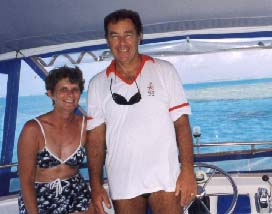 Upon returning to our campsite feeling joyously relieved,
we have a big lunch of sausages, bread, milk, and cookies.
Later, we walk to the east side of the island where Howard and Glynnis
pick us up in their dinghy and take us to their boat. We learn their
yacht is a 37 foot Australian made Franklin with diesel power. It is
equipped with solar panels and a PUR reverse-osmosis watermaker which
converts salt water into fresh water. They have a refrigerator and two
freezers, and by using mainly solar power, they can stay away from port
for up to two months.
They live full time on the boat, studying the bible and Christianity by
reading books and watching VCR tapes. Their favorite anchorages are the
lagoons of Lady Musgrave Island and the Fairfax Islands north
of here.
Upon returning to our campsite feeling joyously relieved,
we have a big lunch of sausages, bread, milk, and cookies.
Later, we walk to the east side of the island where Howard and Glynnis
pick us up in their dinghy and take us to their boat. We learn their
yacht is a 37 foot Australian made Franklin with diesel power. It is
equipped with solar panels and a PUR reverse-osmosis watermaker which
converts salt water into fresh water. They have a refrigerator and two
freezers, and by using mainly solar power, they can stay away from port
for up to two months.
They live full time on the boat, studying the bible and Christianity by
reading books and watching VCR tapes. Their favorite anchorages are the
lagoons of Lady Musgrave Island and the Fairfax Islands north
of here.
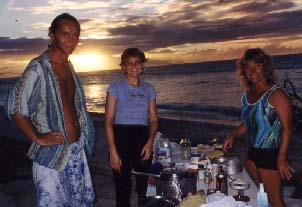 We go back to our campsite and invite Leslie and Tony over to our
table for our last dinner on the island. As the sun sets in the west,
we prepare a feast of the fish, vegetables, bread, cookies, and milk which
were given to us by Glynnis and Howard. It is such a relief to know that
a ship is coming to get us tomorrow!
We go back to our campsite and invite Leslie and Tony over to our
table for our last dinner on the island. As the sun sets in the west,
we prepare a feast of the fish, vegetables, bread, cookies, and milk which
were given to us by Glynnis and Howard. It is such a relief to know that
a ship is coming to get us tomorrow!
Day 9.
The sun is out, but the wind is still gusty. We have breakfast eating the
last of the sausages, bread, and tea, and we start packing up to break camp.
The radio says that Cyclone Rona had hit the mainland north of Cairns, and
there had been extensive flooding north of Cairns and south of Cairns all
the way to Townsville. Several locations had received nearly one meter of
rain in less than 48 hours. The main north-south highway between
the towns was closed.
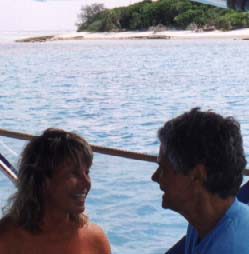 At about 11 AM we see the M.V. Lady Musgrave coming in the distance.
Hooray! We finish loading our equipment and take it to the east
side of the island, where we are picked up by a glass bottom boat and
taken to the main boat. We are saved!
At about 11 AM we see the M.V. Lady Musgrave coming in the distance.
Hooray! We finish loading our equipment and take it to the east
side of the island, where we are picked up by a glass bottom boat and
taken to the main boat. We are saved!
On the M.V. Lady Musgrave they have set up a large buffet
lunch which we eat as we drink the best "cold" beer that we have
ever had. At 3 PM we look back at Lady Musgrave Island as the boat departs
for Bundaberg. We then look at each other and thank God for helping us
through the last nine days.
As we approach Bundaberg our captain radios ahead and arranges for a
rental car to meet us at the dock at 5:45 PM. We pick up the car, rent
a pleasant motel room, and have a gratifying dinner at the motel restaurant.
Day 10.
It is February 14, 1999. We drive our rental car one and one half
hours north to the Town of 1770, where we had left our first rental car.
Then we drive both cars back to Bundaberg and turn in the second rental car.
Listening to the radio and reading newspapers, we learn that Cyclone Rona
is being described as the most damaging cyclone to hit the east coast of
Australia since Cyclone Tracy hit Darwin on Christmas day in 1974. The wind
damage from Cyclone Rona was not substantial, but the property and crop
damage from flooding were enormous.
At 2 PM we leave Bundaberg driving north and heading to the Whitsunday Islands
in search of our next adventure.
- ABC News Reports on Cyclone Rona.
 Lady Musgrave Island is a true coral cay situated off the
east coast of Australia 37 miles east of the Town of 1770 and
62 miles northeast of the city of Bundaberg. This 35 acre island
is surrounded on all sides by a breathtakingly beautiful 3,000 acre
coral lagoon which is unique to the entire Great Barrier Reef region.
Lady Musgrave Island is a true coral cay situated off the
east coast of Australia 37 miles east of the Town of 1770 and
62 miles northeast of the city of Bundaberg. This 35 acre island
is surrounded on all sides by a breathtakingly beautiful 3,000 acre
coral lagoon which is unique to the entire Great Barrier Reef region.
 The boat is anchored to a buoy on the east side of the island.
We reject the free lunch on board the boat, because we are eager to set
up our campsite and explore the island. They ferry us and our gear
to the island in a glass bottom boat. There is a trail through
the trees to the campground, which took us fifteen minutes to walk.
We are the only campers on the island, and we choose the best campsite under
a tree and overlooking the lagoon. There are
some large logs and pieces of coral in front of the campsite, which we
learn later are to keep the large turtles from coming into our tent.
The boat is anchored to a buoy on the east side of the island.
We reject the free lunch on board the boat, because we are eager to set
up our campsite and explore the island. They ferry us and our gear
to the island in a glass bottom boat. There is a trail through
the trees to the campground, which took us fifteen minutes to walk.
We are the only campers on the island, and we choose the best campsite under
a tree and overlooking the lagoon. There are
some large logs and pieces of coral in front of the campsite, which we
learn later are to keep the large turtles from coming into our tent.
 It is a beautiful day, and we are hot from setting up camp. We
cool off by snorkeling in the lagoon. We see for the first time the beauty
of the colorful underwater fish and coral. We then take a walk around the
beach of the entire island. It is about a 30 minute walk, but we
take much longer because we stop many times to enjoy the spectacular
scenery. On the south side of the island there is a metal tower with
a solar powered lighthouse on top. The only building on the entire
island is the "bush toilet" on the south side. But it is the most
impressive outhouse that we have ever seen because it is a solar powered
composting toilet. There is no smell, and we marvel at how it works.
A sign says that the compost is used as fine top soil.
It is a beautiful day, and we are hot from setting up camp. We
cool off by snorkeling in the lagoon. We see for the first time the beauty
of the colorful underwater fish and coral. We then take a walk around the
beach of the entire island. It is about a 30 minute walk, but we
take much longer because we stop many times to enjoy the spectacular
scenery. On the south side of the island there is a metal tower with
a solar powered lighthouse on top. The only building on the entire
island is the "bush toilet" on the south side. But it is the most
impressive outhouse that we have ever seen because it is a solar powered
composting toilet. There is no smell, and we marvel at how it works.
A sign says that the compost is used as fine top soil.
 At 3:45 PM the M.V. Spirit of 1770 departs, leaving us in peace with nature
as the only people on the island.
Returning to our campsite, a beautiful sunset is starting
to form as we both take refreshing solar showers. While watching the
sunset we cook and eat a nice dinner of steak with mushrooms and wine.
A candle-like atmosphere is provided by our Ultra Light Lantern. The
evening is completed with a toast of Grand Marnier, our favorite camping
nightcap.
At 3:45 PM the M.V. Spirit of 1770 departs, leaving us in peace with nature
as the only people on the island.
Returning to our campsite, a beautiful sunset is starting
to form as we both take refreshing solar showers. While watching the
sunset we cook and eat a nice dinner of steak with mushrooms and wine.
A candle-like atmosphere is provided by our Ultra Light Lantern. The
evening is completed with a toast of Grand Marnier, our favorite camping
nightcap.
 Looking in the
sand, we see the three foot wide tracks of two turtles which had nested near
our tent during the night, but we are disappointed that we did not see them.
It is another glorious day. After breakfast it is getting hot on our
leeward side of the island, so we pack up our Therma Lounger chairs,
towels, and snorkel equipment, and we go to the south side of the island
where there is a cool southeasterly breeze. Here we have a memorable day
sunbathing, snorkeling, watching birds, and looking at the beautiful
turquoise water. Hours are spent sitting on the grass in the shade
looking at the splendid sights with a refreshing 15 knot wind blowing
in our faces.
Looking in the
sand, we see the three foot wide tracks of two turtles which had nested near
our tent during the night, but we are disappointed that we did not see them.
It is another glorious day. After breakfast it is getting hot on our
leeward side of the island, so we pack up our Therma Lounger chairs,
towels, and snorkel equipment, and we go to the south side of the island
where there is a cool southeasterly breeze. Here we have a memorable day
sunbathing, snorkeling, watching birds, and looking at the beautiful
turquoise water. Hours are spent sitting on the grass in the shade
looking at the splendid sights with a refreshing 15 knot wind blowing
in our faces.
 With the binoculars we brought, we become fascinated by the water in
the lagoon. The color patterns change as the tide and sun change.
It appears to be a painting in motion. In the distance we see
the white caps of waves breaking on the outer reef. In the lagoon
we see several large fish and turtles and a few manta rays. Overhead
the majestic birds are flying while some are landing on the beach and in
the trees. This must be paradise!
With the binoculars we brought, we become fascinated by the water in
the lagoon. The color patterns change as the tide and sun change.
It appears to be a painting in motion. In the distance we see
the white caps of waves breaking on the outer reef. In the lagoon
we see several large fish and turtles and a few manta rays. Overhead
the majestic birds are flying while some are landing on the beach and in
the trees. This must be paradise!
 Day 3.
In the early morning we hear a turtle moving about six feet away from our
tent, so we get up to take pictures. She digs a big hole and spends
about one and one half hours laying her eggs. She covers her eggs by
sweeping sand into the hole with her flippers and then goes slowly back
out to sea. She must have weighed 150-200 pounds.
Later that day, we see some three inch turtle hatchlings coming up out
of holes in the ground. They are from eggs that had been laid about ten
weeks earlier. The sea gulls are swooping down and picking up the baby
turtles. We try to chase the sea gulls away,
and Lou helps one trapped baby turtle by picking it up and taking it to
the lagoon so it can swim to safety.
Day 3.
In the early morning we hear a turtle moving about six feet away from our
tent, so we get up to take pictures. She digs a big hole and spends
about one and one half hours laying her eggs. She covers her eggs by
sweeping sand into the hole with her flippers and then goes slowly back
out to sea. She must have weighed 150-200 pounds.
Later that day, we see some three inch turtle hatchlings coming up out
of holes in the ground. They are from eggs that had been laid about ten
weeks earlier. The sea gulls are swooping down and picking up the baby
turtles. We try to chase the sea gulls away,
and Lou helps one trapped baby turtle by picking it up and taking it to
the lagoon so it can swim to safety.
 In the afternoon we go back to "our spot" on the south side of the island
where the sun is bright and Lou sunbathes. We also read books, enjoy a
cold beer, and relax to the sights and sounds of the island.
It eventually starts to rain so we
put up our Shelt-a-Hut, a portable rain and sun shelter, but the rain does
not let up, and we head back to our tent while getting drenched by the
rain. We dry off and have dinner, wine, and Grand Marnier in our tent.
In the afternoon we go back to "our spot" on the south side of the island
where the sun is bright and Lou sunbathes. We also read books, enjoy a
cold beer, and relax to the sights and sounds of the island.
It eventually starts to rain so we
put up our Shelt-a-Hut, a portable rain and sun shelter, but the rain does
not let up, and we head back to our tent while getting drenched by the
rain. We dry off and have dinner, wine, and Grand Marnier in our tent.
 Archie fishes for most of an hour with no luck. The wind is blowing
so hard that he cannot get his line out nor control it. It is raining
again, and he is getting drenched. We sit for awhile in
a sheltered area under a tree, but we are getting weak from not
eating all day, so we eat our last two apples core and all.
We decide to save the two candy bars for the very last.
Archie fishes for most of an hour with no luck. The wind is blowing
so hard that he cannot get his line out nor control it. It is raining
again, and he is getting drenched. We sit for awhile in
a sheltered area under a tree, but we are getting weak from not
eating all day, so we eat our last two apples core and all.
We decide to save the two candy bars for the very last.
 Day 8.
The winds did not blow as hard during the night, and it did not rain.
Hopefully, this means that Cyclone Rona is not coming south. In the morning
Archie checks his fishing line which he had left tied to a tree
branch, but no luck.
Day 8.
The winds did not blow as hard during the night, and it did not rain.
Hopefully, this means that Cyclone Rona is not coming south. In the morning
Archie checks his fishing line which he had left tied to a tree
branch, but no luck.
 Upon returning to our campsite feeling joyously relieved,
we have a big lunch of sausages, bread, milk, and cookies.
Later, we walk to the east side of the island where Howard and Glynnis
pick us up in their dinghy and take us to their boat. We learn their
yacht is a 37 foot Australian made Franklin with diesel power. It is
equipped with solar panels and a PUR reverse-osmosis watermaker which
converts salt water into fresh water. They have a refrigerator and two
freezers, and by using mainly solar power, they can stay away from port
for up to two months.
They live full time on the boat, studying the bible and Christianity by
reading books and watching VCR tapes. Their favorite anchorages are the
lagoons of Lady Musgrave Island and the Fairfax Islands north
of here.
Upon returning to our campsite feeling joyously relieved,
we have a big lunch of sausages, bread, milk, and cookies.
Later, we walk to the east side of the island where Howard and Glynnis
pick us up in their dinghy and take us to their boat. We learn their
yacht is a 37 foot Australian made Franklin with diesel power. It is
equipped with solar panels and a PUR reverse-osmosis watermaker which
converts salt water into fresh water. They have a refrigerator and two
freezers, and by using mainly solar power, they can stay away from port
for up to two months.
They live full time on the boat, studying the bible and Christianity by
reading books and watching VCR tapes. Their favorite anchorages are the
lagoons of Lady Musgrave Island and the Fairfax Islands north
of here.
 We go back to our campsite and invite Leslie and Tony over to our
table for our last dinner on the island. As the sun sets in the west,
we prepare a feast of the fish, vegetables, bread, cookies, and milk which
were given to us by Glynnis and Howard. It is such a relief to know that
a ship is coming to get us tomorrow!
We go back to our campsite and invite Leslie and Tony over to our
table for our last dinner on the island. As the sun sets in the west,
we prepare a feast of the fish, vegetables, bread, cookies, and milk which
were given to us by Glynnis and Howard. It is such a relief to know that
a ship is coming to get us tomorrow!
 At about 11 AM we see the M.V. Lady Musgrave coming in the distance.
Hooray! We finish loading our equipment and take it to the east
side of the island, where we are picked up by a glass bottom boat and
taken to the main boat. We are saved!
At about 11 AM we see the M.V. Lady Musgrave coming in the distance.
Hooray! We finish loading our equipment and take it to the east
side of the island, where we are picked up by a glass bottom boat and
taken to the main boat. We are saved!